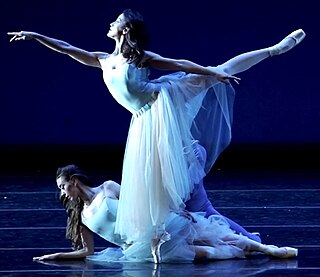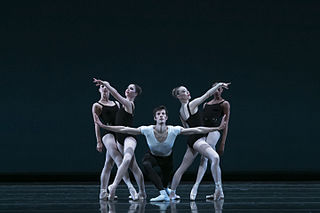Related Research Articles

Ballet is a type of performance dance that originated during the Italian Renaissance in the fifteenth century and later developed into a concert dance form in France and Russia. It has since become a widespread and highly technical form of dance with its own vocabulary. Ballet has been influential globally and has defined the foundational techniques which are used in many other dance genres and cultures. Various schools around the world have incorporated their own cultures. As a result, ballet has evolved in distinct ways.

George Balanchine was an American ballet choreographer of Georgian origin, recognized as one of the most influential choreographers of the 20th-century. Styled as the father of American ballet, he co-founded the New York City Ballet and remained its artistic director for more than 35 years. His choreography is characterized by plotless ballets with minimal costume and décor, performed to classical and neoclassical music.

Lincoln Edward Kirstein was an American writer, impresario, art connoisseur, philanthropist, and cultural figure in New York City, noted especially as co-founder of the New York City Ballet. He developed and sustained the company with his organizing ability and fundraising for more than four decades, serving as the company's general director from 1946 to 1989. According to the New York Times, he was "an expert in many fields", organizing art exhibits and lecture tours in the same years.
Robert Adams Gottlieb was an American writer and editor. He was the editor-in-chief of Simon & Schuster, Alfred A. Knopf, and The New Yorker.
Heather Watts is a former ballet dancer and teacher most known for her time with the New York City Ballet.
Symphony in C, originally titled Le Palais de Cristal, is a ballet choreographed by George Balanchine, to Georges Bizet's Symphony in C. The ballet was originally created for the Paris Opera Ballet, and premiered on July 28, 1947 at Théâtre National de l'Opéra.

Serenade is a ballet by George Balanchine to Tchaikovsky's 1880 Serenade for Strings in C, Op. 48. Serenade is credited as being George Balanchine's first full-length ballet in America. Using the students of his newly formed School of American Ballet, Balanchine choreographed this ballet for an American audience that had not been widely exposed to ballet before. Students of the School of American Ballet gave the first performance on Sunday, 10 June 1934 on the Felix M. Warburg estate in White Plains, N.Y., where Mozartiana had been danced the previous day. It was then presented by the Producing Company of the School of American Ballet on 6 December at the Avery Memorial Theatre of the Wadsworth Atheneum with sets by the painter William Littlefield. Balanchine presented the ballet as his response to the generous sponsorships he received during his immigration to America. The official premiere took place on 1 March 1935 with the American Ballet at the Adelphi Theatre, New York, conducted by Sandor Harmati.

Clive Alexander Barnes was an English writer and critic. From 1965 to 1977, he was the dance and theater critic for The New York Times, and, from 1978 until his death, the New York Post. Barnes had significant influence in reviewing new Broadway productions and evaluating the international dancers who often perform in New York City.
Tschaikovsky Piano Concerto No. 2, also titled Ballet Imperial, is a ballet choreographed by George Balanchine to Tchaikovsky's Piano Concerto No. 2. Ballet Imperial was choreographed for American Ballet Caravan's 1941 South American tour, and was aimed at showing that the Americans were capable of the classical ballet traditions. The ballet pays tribute to Tchaikovsky, the classical ballet choreographer Marius Petipa, and Imperial Saint Petersburg, where Balanchine received his ballet training. The ballet featured academic steps and alludes to Imperial Russia through the costumes and scenery. Ballet Imperial premiered on June 25, 1941, at Teatro Municipal, Rio de Janeiro.
Dance criticism in the United States is the act of producing a written or spoken review of a dance performance. It may also refer to the report itself, which may act as an archived review, critique, or highlight. As with other topics, dance criticism may employ its own technical language, and may also reflect the critic's opinions. Major newspapers cover the arts in some form and dance criticism may be included. Dance criticism is available in other types of media as well, such as online publishing, through blogs, websites, and online videos.

Suki Schorer is an American ballet dancer, ballet mistress, teacher, and writer. She danced with George Balanchine's New York City Ballet from 1959 to 1972. Suki Schorer teaches at the School of American Ballet, the official school of the New York City Ballet and is a Balanchine Trust répétiteur.

The Four Temperaments or Theme and Four Variations is an orchestral work and ballet by Paul Hindemith. Although it was originally conceived as a ballet for Léonide Massine, the score was ultimately completed as a commission for George Balanchine, who subsequently choreographed it as a neoclassical ballet based on the theory of the four temperaments.

Who Cares? is a ballet choreographed by George Balanchine to songs by George Gershwin that were orchestrated by Hershy Kay. The ballet is split in two parts, the first danced by an ensemble, and the second focuses on four principal dancers. Who Cares? premiered on February 5, 1970, at the New York State Theater, danced by the New York City Ballet.
Choreographer Sir Kenneth MacMillan's Royal Ballet production of Sergei Prokofiev's Romeo and Juliet premiered at the Royal Opera House, Covent Garden on 9 February 1965.

Toni Bentley is an Australian-German dancer and writer. Bentley was born in Perth, Western Australia.
George Dorris is an American dance historian, educator, editor, and writer. As managing editor of Dance Chronicle for thirty years, he laid foundations and established standards for dance scholarship not only in the United States but in many other countries of the world. In 2007, he was honored with a lifetime membership in the Society of Dance History Scholars and by the award for Outstanding Service to Dance Research presented by the Congress on Research in Dance.
Balanchine technique or Balanchine method is the ballet performance style invented by dancer, choreographer, and teacher George Balanchine (1904–1983), and a trademark of the George Balanchine Foundation. It is used widely today in many of Balanchine's choreographic works. It is employed by ballet companies and taught in schools throughout North America, including the New York City Ballet and School of American Ballet, where it first emerged.
Stravinsky Violin Concerto, originally titled Violin Concerto, is a neoclassical ballet choreographed by George Balanchine to Stravinsky's Violin Concerto. Balanchine had previously choreographed another ballet to the concerto in 1941 for the Original Ballet Russe, titled Balustrade, though it was not revived following a few performances. He then reused the concerto for New York City Ballet's Stravinsky Festival in 1972, a tribute to the composer following his death. The ballet premiered on June 18, 1972, at the New York State Theater.
Kammermusik No. 2 is a ballet choreographed by George Balanchine to Paul Hindemith's music of the same name. The ballet premiered on January 26, 1978, at the New York State Theater, danced by the New York City Ballet.

Trevor Noël Goodwin was an English music critic, dance critic and author who specialized in classical music and ballet. Described as having a "rare ability to write about music and dance with equal distinction", for 22 years Goodwin was Chief music and dance critic for the Daily Express. He held criticism posts at many English newspapers, including the News Chronicle, Truth and The Manchester Guardian among others; from 1978 to 1998 he also reviewed performances for The Times. Goodwin wrote an early history of the Scottish Ballet and was coauthor for two books: London Symphony: Portrait of an Orchestra with Hubert J. Foss and a Knight at the Opera with Geraint Evans.
References
- ↑ Ballet review. (Journal, magazine, 1965) [WorldCat.org]
- ↑ Robert Greskovic (October 2005). Ballet 101: A Complete Guide to Learning and Loving the Ballet. Hal Leonard Corporation. p. 605. ISBN 978-0-87910-325-5.
- ↑ Steven Belletto; Daniel Grausam (1 October 2012). American Literature and Culture in an Age of Cold War: A Critical Reassessment. University of Iowa Press. p. 57. ISBN 978-1-60938-113-4.
- ↑ "Dance Research Foundation".
- ↑ Robert Gottlieb (2008). Reading Dance: A Gathering of Memoirs, Reportage, Criticism, Profiles, Interviews, and Some Uncategorizable Extras. Pantheon Books. p. 1. ISBN 978-0-375-42122-8.
- ↑ James Wolcott (2 October 2012). Lucking Out: My Life Getting Down and Semi-Dirty in the Seventies New York. Knopf Doubleday Publishing Group. p. 200. ISBN 978-0-7679-3062-8.
- 1 2 Sally Banes; Mikhail Baryshnikov (2003). Reinventing Dance in the 1960s: Everything was Possible. Univ of Wisconsin Press. p. 165. ISBN 978-0-299-18014-0.
- ↑ "Dance Research Foundation".
- ↑ MacAuley, Alastair. "Francis Mason, Voice for Dance Over 5 Decades, Dies at 88"
- ↑ "Bibliography. Balanchine
- ↑ Robert Gottlieb (2008). Reading Dance: A Gathering of Memoirs, Reportage, Criticism, Profiles, Interviews, and Some Uncategorizable Extras. Pantheon Books. p. 1. ISBN 978-0-375-42122-8.
- ↑ New York Times. "Marvin Hoshino Obituary"
- ↑ "Marvin Hoshino (1947-2020)".
- ↑ "Ballet Review - The Premier Dance Journal".
- ↑ "Letter to Subscribers". Ballet Review.
- ↑ "Dance Research Foundation".
- ↑ "The National Endowment for the Arts".
- ↑ "The New York State Council on the Arts".
- ↑ "The Fan Fox and Leslie R. Samuels Foundation".